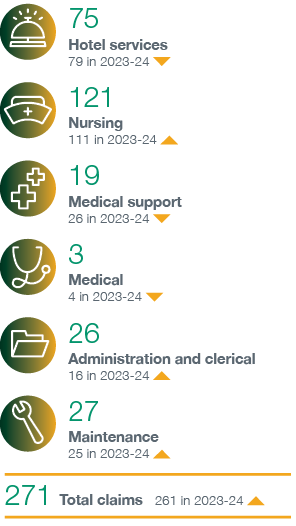Our commitment to workplace safety and wellbeing
EMHS is committed to understanding and managing its health, safety and wellbeing risks to proactively maintain worker wellbeing and prevent injuries. EMHS work health and safety (WHS) systems are regularly audited, with the last systems audit completed in August 2024. During 2024-25 EMHS was issued with 13 improvement notices and 2 prohibition notices from WorkSafe WA. 10 of the notices have been satisfactorily closed out and work is ongoing to ensure the remaining 3 are remedied within the allocated timeframe.
The potential for EMHS workers to be exposed to workplace aggression and violence persists and is the most reported category of workplace incidents. An in-depth analysis of workplace violence and aggression exposure in EMHS led to the development of a contemporary, concise and targeted strategy to manage aggression proactively. Education and training for staff has been reviewed, with particular focus on de-escalation and support for staff. This includes the introduction of the Behaviour Support Team. Click here for more information.
Manual tasks continue to be the most frequent cause of lost time injuries across EMHS. To help address this, a deep analysis was conducted into EMHS’ risk management of manual tasks to identify causes, barriers and priority areas for intervention. The predominant tasks involved in manual task injuries were providing care to bariatric patients, patient transfer, turns and positioning, general loads handling, moving beds, trolleys and wheelchairs, and cleaning tasks. Priority areas for intervention include availability and suitability of equipment, hazardous manual task risk assessments to develop standard operating procedures, work design and continued data collection and learning.
Work health and safety performance indicators
Number of fatalities
| Year | Target | Actual | |
|---|---|---|---|
| Years 2024-25 | Target 0 | Actual 0 |
|
| Years 2023-24 | Target | Actual 0 |
|
| Years 2022-23 | Target | Actual 0 |
|
| Years 2021-22 | Target | Actual 0 |
|
Lost Time Injury and Disease (LTI/D) incident rate (per 100)
| Year | Target | Actual | |
|---|---|---|---|
| Years 2024-25 | Target 0* | Actual 2.76 |
|
| Years 2023-24 | Target | Actual 3.00 |
|
| Years 2022-23 | Target | Actual 2.37 |
|
| Years 2021-22 | Target | Actual 3.07 |
|
LTI/D severity rate (percentage LTI/D)
| Year | Target | Actual | |
|---|---|---|---|
| Years 2024-25 | Target 0* | Actual 55.46% |
|
| Years 2023-24 | Target | Actual 44.94% |
|
| Years 2022-23 | Target | Actual 42.01% |
|
| Years 2021-22 | Target | Actual 40.61% |
|
Percentage of injured workers returned to work within 13 weeks
| Year | Target | Actual | |
|---|---|---|---|
| Years 2024-25 | Target 70.0% | Actual 47.2% |
|
| Years 2023-24 | Target | Actual 48.2% |
|
| Years 2022-23 | Target | Actual 46.3% |
|
| Years 2021-22 | Target | Actual 43.3% |
|
Percentage of injured workers returned to work within 26 weeks
| Year | Target | Actual | |
|---|---|---|---|
| Years 2024-25 | Target 80.0% | Actual 62.3% |
|
| Years 2023-24 | Target | Actual 61.8% |
|
| Years 2022-23 | Target | Actual 66.5% |
|
| Years 2021-22 | Target | Actual 60.6% |
|
Percentage of managers and supervisors trained in occupational safety, health and injury management responsibilities
| Year | Target | Actual | |
|---|---|---|---|
| Years 2024-25 | Target 80.0% | Actual 82.0% |
|
| Years 2023-24 | Target | Actual 73.5% |
|
| Years 2022-23 | Target | Actual 63.1% |
|
| Years 2021-22 | Target | Actual 72.3% |
|
*Or 10% improvement on the previous 3 years
Governance, compliance and consultation
EMHS has active Work Health and Safety committees covering all departments. These committees are made up of elected health and safety representatives (HSRs) and management representatives who facilitate consultation and communication and are an escalation point for work health and safety matters. As at the end of 2024-25, EMHS had 308 elected HSRs, 278 of whom have completed a 5-day introductory course, ensuring workers are represented on all issues relating to their health and safety in the workplace. EMHS WHS facilitates an education program providing opportunities for in-service training and support for all HSRs.
Injury Management
EMHS’ systematic approach to workplace-based injury management services following work related injuries and illnesses fosters an environment where workers return safely to productive employment as soon as practicable. The new Workers’ Compensation and Injury Management Act 2023 (the Act) came into effect on 1 July 2024, with changes implemented across EMHS in 2024-25 to meet the requirements of the new Act. EMHS has an Injury Management team within the Workplace Health and Safety department that supports managers, injured workers and treating practitioners to achieve the best outcomes for injured workers and the organisation in collaboration with the Insurance Commission of WA (ICWA).
Worker’s compensation (WC) and injury management (IM) improvements were introduced in 2024-25 across four key strategy areas:
- injury prevention – in depth analysis of data such as pre-claim data, workforce demographics, hazard and incident data and WC and IM performance to examine workplace high-impact hazards including psychosocial, manual tasks, and workplace aggression in high-risk areas
- supporting workers – review to streamline Physiotherapy Early Intervention Injury Management Program, and early access to funds for medical treatment while WC claim liability is being determined through ICWA
- supporting EMHS and managers – facilitation by EMHS of a WA Health and ICWA collaborative forum for shared learning and improvement in WC and IM performance, improvements in claims review meetings with ICWA and with managers and supervisors, and improvement in long-tail claims management
- reducing re-injury – development of process to improve post-injury manual task support for patient support workers.
Injury Management services were internally audited in 2024-25.
Additionally, the IM team works with EMHS Human Resources and managers to support workers with a personal illness or injury to remain safe and productive at work wherever possible.
2024-25 workers’ compensation claims by occupational category


